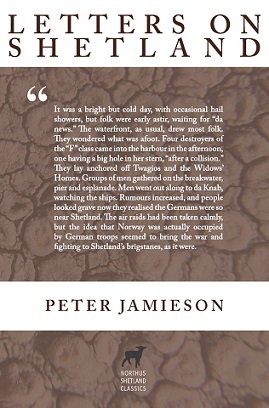Review of Letters on Shetland, by Peter Jamieson, pub. Northus Shetland Classics, 2022

The latest in a series of reprints of Shetland classics, this was first published in 1949. It is a series of descriptions of various aspects of Shetland life, couched in the form of letters to a probably imaginary correspondent living outside Shetland. The “imaginary” is not certain, but while many of the anecdotes and descriptions would have been delightful to receive in the post, I personally decline to believe that any correspondent, anywhere, would have welcomed reams of statistics, or wanted to know how many hooks go to a cod line or how much tarmac was laid at Sumburgh airport. They don’t read like letters to me, especially by contrast with the genuine letters from others which are often quoted, and I think the letter form is purely a literary convention here.
His description of people, places and events, often from personal experience or the accounts of those who had known them, can be very lively. In November 1939 the Lerwick blackout, in a town already dark enough in winter, began causing accidents:
"The night watchman at the pier, a man over 80 years old, fell over the side of the pier. He got caught in the steamer’s hawser just in time and managed to hang on while men came to his rescue. After this he walked home by himself and returned to work soon after."
Then there is his account of religious observances in Fair Isle:
"There are two churches, Wesleyan and Church of Scotland, and as the population is not large enough to make two congregations, it used to be the custom that people able to go to the kirk would go to the Wesleyan Chapel for morning prayer and to the “big kirk” in the afternoon. Then the following Sunday the order would be reversed; in this way any jealousy was dispelled."
The chapters (or letters, as he calls them) deal with history, notable individuals, topography, fishing and sailing, crofting, politics, the dialect and social change in the islands. Writing in 1949, he could not foresee either the oil boom or the rise of the SNP, and in the last chapter, where he considers “what could be done to bring about a higher standard of living in the islands”, his answer revolves around Labour Party policy of the time. Before the war he had helped to found a short-lived branch of the Communist party but by 1945 he was campaigning for Labour, in the person of his wonderfully named friend Prophet Smith, in the constituency of Orkney & Shetland. It wasn’t to be; Jo Grimond won the seat for the Liberals in 1950 and the Lib Dems who succeeded his party still hold it, uninterrupted, over 70 years later, with the SNP second and creeping up, while Labour and the Tories try desperately to save their deposits.
He is at his least gripping when he gets mired in statistics. If he hadn’t determined on this ”letters” convention, he could have put them out of the way in appendices, but I suspect he actually finds them interesting for their own sake and does not realise how quickly they make most people’s eyes glaze over.
Nevertheless, this is a fascinating record of life as it was in the islands in his time, and for some time before. It preserves a great deal of riveting material in the form of memories, letters, court cases and newspaper reports. This is Reynolds’ News, in October 1939, reporting on an interruption to the Lerwick blackout:
"Lerwick, Shetland Islands, witnessed a magnificent aurora borealis which changed night almost into day on Friday. The whole sky was illuminated by great swiftly moving shafts of brilliant yellow, green, mauve and red lights. ARP wardens threw in the sponge and called it a day."



